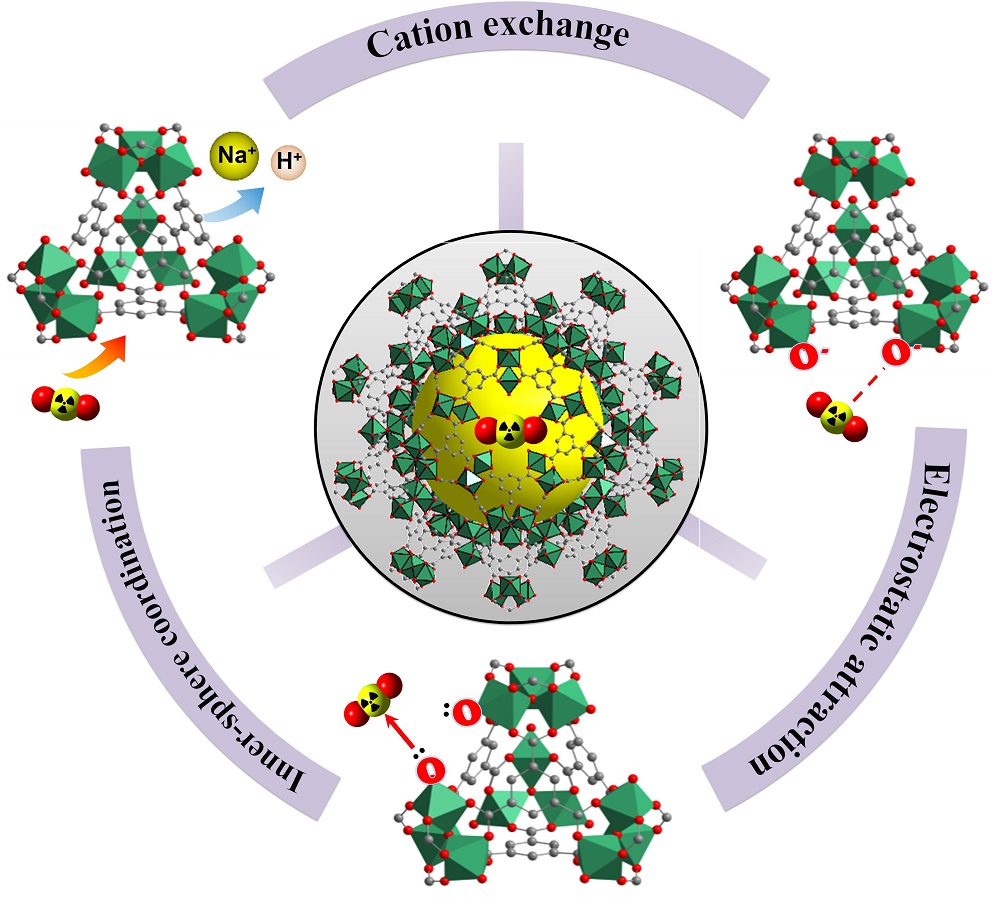Due to ever-increasing global energy consumption and the increasingly prominent environmental issues in recent years, it is increasingly urgent to find new non-fossil energy sources [
1]. Nuclear power is considered a “clean energy” in view of none emission of greenhouse gases and extremely high energy density that can meet the growing energy demand of humanity [
2,
3]. At the same time, however, various ecotoxic radionuclides from the nuclear fuel cycle are released into the environment, which causes a huge negative effect on the environment and humanity health [
4]. Therefore, novel materials and technologies are anticipated to improve the nuclear fuel cycle [
5,
6]. In particular, novel sorbents are critically needed to extract uranium from waste streams and acid mine drainages [
7–
9]. As such, a number of solid-phase sorbents, such as porous carbon [
10,
11], metal oxides [
12], graphene oxides [
13–
15], and layered double hydroxides [
16,
17], have been developed over the last decades for the uptake of the radionuclides. Among these sorbents, metal–organic frameworks (MOFs), also known as porous coordination polymer, are becoming a new favorite. MOFs are highly porous hybrid crystalline solids consisting of central metal ions or clusters and organic linkers. As emerging materials with extraordinary porosity, tunable composition and excellent chemical and structure stability resulting from the combined impacts of their organic and inorganic moieties, MOFs are gaining immense attention and showing a range of promising applications in gas storage [
18,
19], separations [
20–
22], sensing [
23], catalysis [
24], and drug delivery [
25]. Moreover, these porous structures with pores of molecular dimensions are associated with a series of desirable properties such as low density, ultrahigh surface area to mass ratio. Recently, MOFs as sorbents of radionuclides have been reported by us and others. Lin et al. [
26], for example, reported the highly porous Zr-based MOFs UiO-68-(NH)(PO)(OEt)
2 for U(VI) extraction. The experimental results confirm that the MOFs can effectively adsorb U(VI) and the saturation capacity reaches 217 mg·g
–1 from water at pH = 2.5. Derivatives of MIL-101 were utilized as sorbents to remove U(VI) from water [
27]. Amine functional groups on the frameworks of MIL-101(Cr) greatly enhance the U(VI) uptake onto the MOFs. Moreover, we reported, for the first time, a highly efficient Th(IV) sorption with the carboxyl derivatives of UiO-66 [
28]. These results clearly present opportunities for separating MOFs in radionuclides from wastewater. Up to now, however, the questions of whether or not the structure and component of MOFs correlates with their adsorbability and selectivity towards certain radionuclides has been rarely addressed. Very recently, we have published a study on defect engineering of UiO-66 with more active binding sites and more open frameworks for U(VI) capture from wastewater [
29]. It is found that tailoring missing-linker defects drastically improves U(VI) uptake in the MOFs. In this work, another key issue affecting U(VI) uptake in MOFs has been addressed, i.e., metal node. Several studies have already proven that the adsorption properties of porous isostructural MOFs can be greatly changed by modulating center metals/clusters. Yoon et al. [
30] for example, proposed that very large differences in N
2 adsorption occurred among the MIL-100(Cr), MIL-100(Al) and MIL-100(Fe) MOFs. Tong et al. [
31] reported that MIL-100s (Fe, Cr) show very different dye capture behaviors. MIL-100(Fe) can efficiently capture both the anionic methyl orange (MO) and the cationic methylene blue (MB) with rapid kinetics simultaneously, while MIL-100(Cr) can selectively adsorb MB from an equal mass MO-MB mixture. All of these works demonstrated metal node effect on the adsorption properties of MOFs. Although our recent work [
32] had revealed the influence of metal node on U(VI) uptake into MOFs, no data on the metal ions adsorption has been published.







